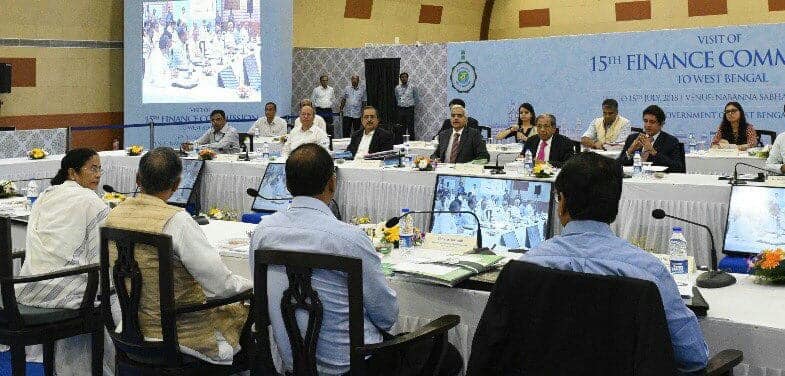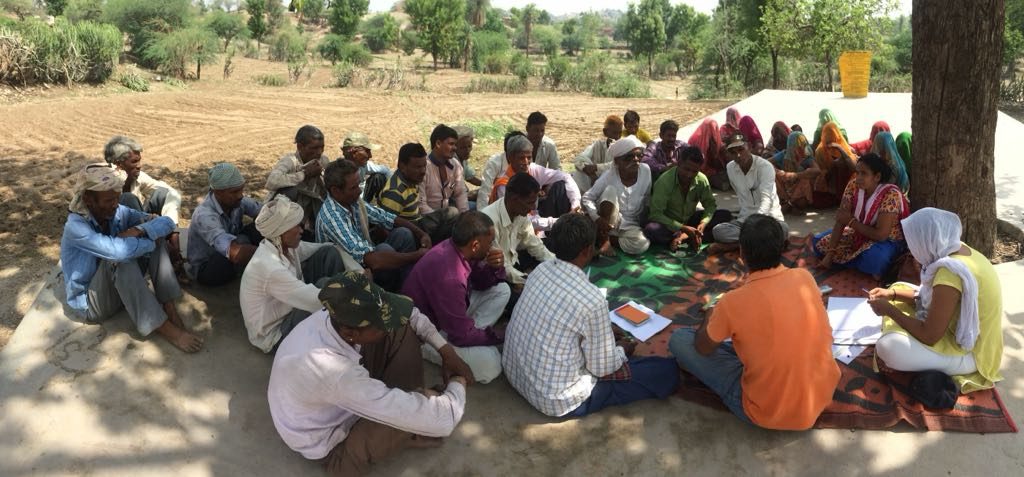
With the Fifteen Finance Commission set to give its recommendations for the allocation of funds for local governance in the last quarter of this year, it is important to understand the challenges for effective decentralized planning in rural India.
Based on my experience of working with local governance institutions and community in rural Rajasthan, three types of institutional challenges can be observed with regard to decentralised planning in rural India.
First: at the Gram Sabha level focusing on real-time participation. Second: at the Gram Panchayat (GP) level focusing on the capacity. Third: lack of social accountability framework for the implementation of Gram Panchayat Development Plans (GPDPs). These challenges impede the formation of GPDP. Thus, it is imperative for the government to consider these challenges for effective decentralised planning.
GPDP – A vital link in decentralised planning
In India, the process of decentralisation was legitimized through the 73rd and 74th Constitutional Amendment Act of 1993 in rural and urban areas respectively. These amendments focussed on political and administrative decentralisation, while lesser attention was attributed to fiscal decentralisation.
In 2015, the Fourteenth Finance Commission (FC XIV) devolved funds directly to the Gram Panchayats[1] for decentralised planning. This was a major step towards fiscal decentralisation. In this, there was direct devolution of funds at the panchayat level in two categories i.e. Basic grant and Performance grant. This constituted over 200,000 crore Rupees to all the gram panchayats in India. Further, FC XIV asked the state governments to form guidelines for the implementation of the same.
In Rajasthan, the state government issued guidelines called “Aapni Yojana Aapno Vikas” [2] for the preparation of GPDP to discuss and make plans for the utility of funds. As per the guidelines, GPDP is to be formed based on the proposals and priorities of the Gram Panchayat, after seeking due approval of the Gram Sabha. The government of Rajasthan also took initiatives for the making of good quality GPDPs – with instructions for compulsory inclusion of works of human and social development such as education, health, nutrition, sanitation, social justice in line with the Sustainable Development Goals.
A glimpse of budget resource for GPDP:
There are two major sources of funds for decentralised planning – one from the central government as per the Central Finance Commission (CFC) and two from the state government as per the State Finance Commission.
Also, there are funds from other government schemes like Mahatma Gandhi National Rural Employment Guarantee Act (MGNREGA), Swachh Bharat Abhiyan, PM Awas Yojna and Social Security Pension which focus on individual benefits. Funds from flagship programmes like Sarva Shiksha Abhiyan and National Rural Health Mission are allocated at the institutional level.

MP LAD, MLA LAD and Panchayat Samiti funds are three other funds for rural development. These funds are unevenly distributed and are under the discretion of individual MP and MLA. Further, there are own source revenue, donations and corporate social responsibility funds available at the Panchayats for development in their area.
Thus, there is an influx of funds from varied sources to the Panchayats, which can be further leveraged based upon the planning capacity of the Panchayats. However, these funds are not being planned and utilized effectively due to the challenges in planning.
Institutional Challenges of decentralised planning in rural Rajasthan:
Decentralised planning is facing institutional challenges through weaker participation at the Gram Sabha, under capacity of Gram Panchayat officials and representatives, and lack of social accountability framework for effective implementation of GPDP. These weaknesses in the rural governance systems have been institutionalised by PRI members and street level bureaucrats for their self-interests, which is further weakening the decentralised planning processes.
At the Gram Sabha level:
Gram Sabhas have constitutional status and reinforce the participatory processes in decentralised planning. GPDP is to be discussed and formed after the approval of the Gram Sabha after 2nd October. However, last year in Rajasthan, panchayat officials were on strike on 2nd October, after which the model code of conduct was implemented for the state assembly elections. Therefore, Gram Sabhas were conducted after the elections during the last week of December in a symbolic manner.
In many cases, people were not informed about the conduct of Gram Sabhas and the GPDP was formed by officials and representatives of the GP. There was no real participation by the Gram Sabhas, except for the approval from the mandatory quorum of 10% of the Gram Sabha members. Further, most of these GPDPs focussed on infrastructure issues like building roads, canals etc. There was no focus on health, nutrition, education and livelihood issues. The participation of line departments in the token Gram Sabhas too was perfunctory.
Further, in case of tribal areas, PESA mandates the conduct of Gram Sabhas in revenue villages. However, Panchayat officials do not recognise these and conduct Gram Sabhas at the Panchayat level. For instance, in parts of Dungarpur districts which come under Schedule V areas of the Constitution of India, Village Devlopment Plans (VDPs) have been formed by the PESA Gram Sabhas which need to be further incorporated in the GPDP. However, many a times, Panchayats do not accept the VDPs formed by PESA Gram Sabhas for including them in the GPDP.
Thus, non-deliberative and hastened making of GPDPs has resulted in the institutional weakening of Gram Sabhas. Participation, Representation and Decision-making are the three key elements of Gram Sabhas. Weakening of any of these elements adversely affects the processes of participatory planning and the essence of decentralisation.
At the Gram Panchayat level:
There is a hierarchal understanding amongst the Panchayat officials about the GPDP plan. The common understanding is that funds can be sourced only from the central and state allocations as recommended by the respective FCs. Many Sarpanchs are not aware about the resource envelope available at the panchayat level. The GPDPs thus formed does not converge funds from different schemes and resources available at the Panchayat level.
Further, the panchayat officials and representatives are overburdened and under capacitated. In many panchayats, one Sachiv is working in two GPs or the lower level staff are working as Sachivs. Line Department officials like health workers, teachers too are overburdened and not held accountable for their work.
Thus, it is imperative to capacitate the Panchayat officials and representatives so that they form and implement the plans with due participation of people, and not capture the planning process. Also, there needs to be adequate number of officials at Panchayat level and line departments along with the effective distribution of work amongst officials.
Social Accountability:
In many cases, after the sanctioning of the GPDP, Panchayat officials and representatives misinform people about the approved works. Many a times, Panchayat representatives do not implement the work at the mentioned location as per the plan but implement the work in areas of their interest colluding with of Junior Engineer (JEN) and Sachivs. Further, different means of corruption like using poor quality material, directing resources to personal use mar the implementation. Thus, it is imperative to have social accountability tools for effective implementation of GPDP.
For this, first, all plans need to be disclosed not only on Plan Plus but also publicly disclosed in GP and other village level institutions where people from the village can easily access them. Presently, Section 4(1)(b) of the Right to Information Act (RTI) calls for proactive disclosure of the work done by the GPs, but this rule has not been implemented effectively. Second, there should be special Gram Sabhas for the announcement of GPDP in which a follow-up strategy should be formed for its effective implementation, monitored by a group of community members. Third, quarterly social audits should be conducted at the GP level. Presently social audits are part of NREGA. Similar model can be replicated for GPDPs.
Way Forward:
The steps taken by FC XIV towards strengthening the panchayat planning processes through fiscal decentralisation are significant. Now, when Finance Commission XV will be giving its recommendations, it is important for the government to consider the above challenges for effective utilization of these funds.
Decentralised
planning should be reinforced by focussing on three key areas – Gram Sabhas, Gram
Panchayats and social accountability. Increasing participation and
representation in Gram Sabhas along with their regular conduct, capacitating
Gram Panchayats for leveraging and converging funds for planning, and ensuring
effective implementation of plans by strengthening social accountability – will
enable inclusive, participatory and sustainable development in rural India.
[1] Article 243G of the Constitution of India acknowledges Gram Panchayats as institutions of local self-government and mandates them to prepare plans for economic development and social justice.
[2] Available from – https://rural.nic.in/sites/default/files/AAP_EC_PPT_Rajasthan.pdf
Rajat works with Astha, strengthening local democracy and rural governance institutions in Dungarpur, Rajasthan. He has worked with PRS Legislative Research as Legislative Assistant to Member of Parliament (LAMP) Fellow and Mazdoor Kisaan Shakti Sanghtan. He has studied Development (Law & Governance) at Azim Premji University, Bangalore and Journalism at the University of Delhi. He is keenly interested in decentralization and understanding the challenges of governance in rural areas.